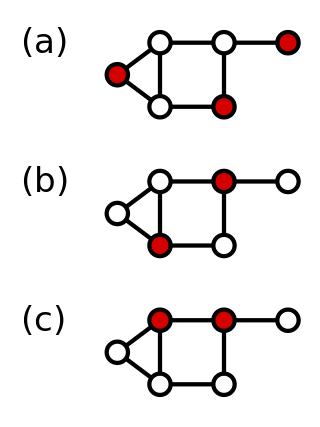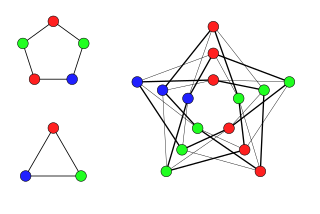The eight queens puzzle is the problem of placing eight chess queens on an 8×8 chessboard so that no two queens threaten each other; thus, a solution requires that no two queens share the same row, column, or diagonal. There are 92 solutions. The problem was first posed in the mid-19th century. In the modern era, it is often used as an example problem for various computer programming techniques.

In graph theory, a circle graph is the intersection graph of a chord diagram. That is, it is an undirected graph whose vertices can be associated with a finite system of chords of a circle such that two vertices are adjacent if and only if the corresponding chords cross each other.

In graph theory, a dominating set for a graph G is a subset D of its vertices, such that any vertex of G is in D, or has a neighbor in D. The domination numberγ(G) is the number of vertices in a smallest dominating set for G.
In graph theory, a connected dominating set and a maximum leaf spanning tree are two closely related structures defined on an undirected graph.

In graph theory, a king's graph is a graph that represents all legal moves of the king chess piece on a chessboard where each vertex represents a square on a chessboard and each edge is a legal move. More specifically, an king's graph is a king's graph of an chessboard. It is the map graph formed from the squares of a chessboard by making a vertex for each square and an edge for each two squares that share an edge or a corner. It can also be constructed as the strong product of two path graphs.

In graph theory, a rook's graph is an undirected graph that represents all legal moves of the rook chess piece on a chessboard. Each vertex of a rook's graph represents a square on a chessboard, and there is an edge between any two squares sharing a row (rank) or column (file), the squares that a rook can move between. These graphs can be constructed for chessboards of any rectangular shape. Although rook's graphs have only minor significance in chess lore, they are more important in the abstract mathematics of graphs through their alternative constructions: rook's graphs are the Cartesian product of two complete graphs, and are the line graphs of complete bipartite graphs. The square rook's graphs constitute the two-dimensional Hamming graphs.

In the mathematical area of graph theory, a triangle-free graph is an undirected graph in which no three vertices form a triangle of edges. Triangle-free graphs may be equivalently defined as graphs with clique number ≤ 2, graphs with girth ≥ 4, graphs with no induced 3-cycle, or locally independent graphs.

In graph theory, Hedetniemi's conjecture, formulated by Stephen T. Hedetniemi in 1966, concerns the connection between graph coloring and the tensor product of graphs. This conjecture states that

In the study of graph coloring problems in mathematics and computer science, a greedy coloring or sequential coloring is a coloring of the vertices of a graph formed by a greedy algorithm that considers the vertices of the graph in sequence and assigns each vertex its first available color. Greedy colorings can be found in linear time, but they do not, in general, use the minimum number of colors possible.
In graph theory, a mathematical discipline, coloring refers to an assignment of colours or labels to vertices, edges and faces of a graph. Defective coloring is a variant of proper vertex coloring. In a proper vertex coloring, the vertices are coloured such that no adjacent vertices have the same colour. In defective coloring, on the other hand, vertices are allowed to have neighbours of the same colour to a certain extent.
A mathematical chess problem is a mathematical problem which is formulated using a chessboard and chess pieces. These problems belong to recreational mathematics. The most well-known problems of this kind are the eight queens puzzle and the knight's tour problem, which have connection to graph theory and combinatorics. Many famous mathematicians studied mathematical chess problems, such as, Thabit, Euler, Legendre and Gauss. Besides finding a solution to a particular problem, mathematicians are usually interested in counting the total number of possible solutions, finding solutions with certain properties, as well as generalization of the problems to N×N or M×N boards.

In graph theory, a well-covered graph is an undirected graph in which the minimal vertex covers all have the same size. Here, a vertex cover is a set of vertices that touches all edges, and it is minimal if removing any vertex from it would leave some edge uncovered. Equivalently, well-covered graphs are the graphs in which all maximal independent sets have equal size. Well-covered graphs were defined and first studied by Michael D. Plummer in 1970.

In mathematics, the telephone numbers or the involution numbers form a sequence of integers that count the ways n people can be connected by person-to-person telephone calls. These numbers also describe the number of matchings of a complete graph on n vertices, the number of permutations on n elements that are involutions, the sum of absolute values of coefficients of the Hermite polynomials, the number of standard Young tableaux with n cells, and the sum of the degrees of the irreducible representations of the symmetric group. Involution numbers were first studied in 1800 by Heinrich August Rothe, who gave a recurrence equation by which they may be calculated, giving the values
In graph theory, a branch of mathematics, an indifference graph is an undirected graph constructed by assigning a real number to each vertex and connecting two vertices by an edge when their numbers are within one unit of each other. Indifference graphs are also the intersection graphs of sets of unit intervals, or of properly nested intervals. Based on these two types of interval representations, these graphs are also called unit interval graphs or proper interval graphs; they form a subclass of the interval graphs.
In graph theory, an eternal dominating set for a graph G = (V, E) is a subset D of V such that D is a dominating set on which mobile guards are initially located (at most one guard may be located on any vertex). The set D must be such that for any infinite sequence of attacks occurring sequentially at vertices, the set D can be modified by moving a guard from an adjacent vertex to the attacked vertex, provided the attacked vertex has no guard on it at the time it is attacked. The configuration of guards after each attack must induce a dominating set. The eternal domination number, γ∞(G), is the minimum number of vertices possible in the initial set D. For example, the eternal domination number of the cycle on five vertices is two.

In graph theory, a universal vertex is a vertex of an undirected graph that is adjacent to all other vertices of the graph. It may also be called a dominating vertex, as it forms a one-element dominating set in the graph. A graph that contains a universal vertex may be called a cone, and its universal vertex may be called the apex of the cone. This terminology should be distinguished from the unrelated usage of these words for universal quantifiers in the logic of graphs, and for apex graphs.
In graph theory, a cop-win graph is an undirected graph on which the pursuer (cop) can always win a pursuit–evasion game against a robber, with the players taking alternating turns in which they can choose to move along an edge of a graph or stay put, until the cop lands on the robber's vertex. Finite cop-win graphs are also called dismantlable graphs or constructible graphs, because they can be dismantled by repeatedly removing a dominated vertex or constructed by repeatedly adding such a vertex. The cop-win graphs can be recognized in polynomial time by a greedy algorithm that constructs a dismantling order. They include the chordal graphs, and the graphs that contain a universal vertex.
The independence complex of a graph is a mathematical object describing the independent sets of the graph. Formally, the independence complex of an undirected graph G, denoted by I(G), is an abstract simplicial complex (that is, a family of finite sets closed under the operation of taking subsets), formed by the sets of vertices in the independent sets of G. Any subset of an independent set is itself an independent set, so I(G) is indeed closed under taking subsets.
In mathematics, a queen's graph is an undirected graph that represents all legal moves of the queen—a chess piece—on a chessboard. In the graph, each vertex represents a square on a chessboard, and each edge is a legal move the queen can make, that is, a horizontal, vertical or diagonal move by any number of squares. If the chessboard has dimensions , then the induced graph is called the queen's graph.
A chessboard complex is a particular kind of abstract simplicial complex, which has various applications in topological graph theory and algebraic topology. Informally, the (m, n)-chessboard complex contains all sets of positions on an m-by-n chessboard, where rooks can be placed without attacking each other. Equivalently, it is the matching complex of the (m, n)-complete bipartite graph, or the independence complex of the m-by-n rook's graph.











